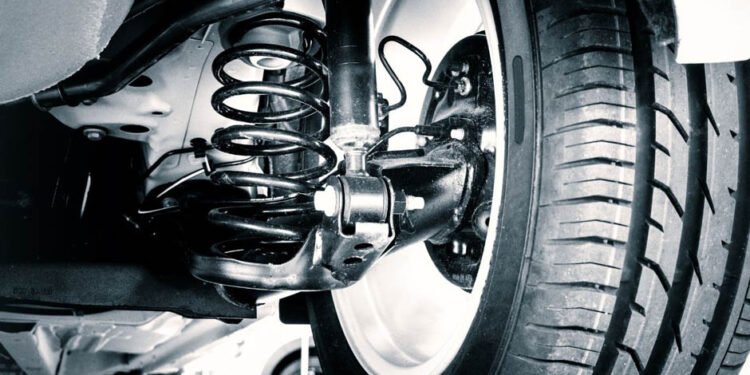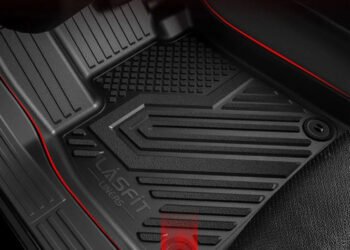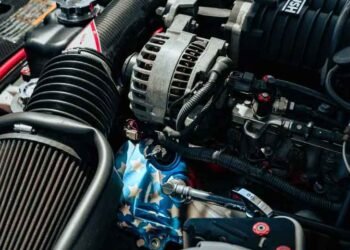Shock absorbers, commonly referred to simply as “shocks,” play a pivotal role in the automotive world by providing stability and comfort to the driving experience. They are hydraulic (or in some cases, pneumatic) devices designed to control the impact and rebound movement of a vehicle’s suspension and springs.
Whether you have basic shocks, or the fancy bilstein 5100 shocks, shocks are crucial in maintaining the tires’ contact with the road, providing stability by controlling spring and suspension movement, and ensuring comfort by mitigating and absorbing excess energy from road irregularities.
This exploration delves into the foundational principles, anatomy, and types of shock absorbers, providing insights into their functionality, configurations, and their consequential impact on vehicle performance and safety.
Fundamental Principles of Shock Absorbers
Purpose and Functionality
Shock absorbers are engineered to absorb and dissipate the kinetic energy derived from vehicle movement and road irregularities, converting it into thermal energy, which is subsequently dispersed through the hydraulic fluid.
By controlling the oscillation of springs and suspension, shocks ensure that the vehicle’s tires consistently maintain contact with the road, offering optimal traction and maneuverability.
Basic Working Mechanism
Shocks contain hydraulic fluid (or gas) that flows through internal valves and chambers. When the vehicle encounters a bump or dip, kinetic energy forces the fluid through these valves, which in turn, converts the energy into heat.
The resistive force provided by the shock absorber dampens the oscillation of the vehicle’s springs, ensuring they swiftly return to a rest position after absorbing an impact, subsequently enhancing ride comfort and stability.
Anatomy of a Shock Absorber
Key Components and Their Functions
The piston moves within a cylinder filled with hydraulic fluid, forcing the fluid through valves that regulate fluid flow, and thus, controlling the damping rate of the shock absorber.
Valves regulate the flow of hydraulic fluid within the shock, controlling the rate of compression and rebound of the piston. The hydraulic fluid, meanwhile, absorbs and dissipates the heat generated during this process.
Seals prevent the leakage of hydraulic fluid, maintaining the internal pressure of the shock absorber. Bushings help to attach the shock absorber to the vehicle and assist in minimizing vibrations.
Mountings facilitate the installation of the shock absorber between the vehicle’s frame and axle, ensuring optimal alignment and functionality.
Variations in Design
Utilizing a single cylinder configuration, monotube shocks often provide enhanced performance and are common in racing and off-road applications.
Featuring a dual cylinder design, twin-tube shocks provide a balance of comfort and performance, making them suitable for a wide range of general-purpose applications.
Other design variations cater to specific applications and performance requirements, including gas-charged, coilover, and electronically controlled shock absorbers.
Types of Shock Absorbers
Standard (Conventional) Shock Absorbers
Standard shock absorbers, often found in various vehicle models, predominantly serve to control spring and suspension movement, mitigating excessive vibrations and ensuring tire adherence to the road. Employing a straightforward hydraulic mechanism, these shocks offer a balanced ride quality suitable for general driving conditions, seamlessly combining comfort and stability.
Strut Type Shock Absorbers
Strut type shocks, with McPherson struts being a prevalent example, not only absorb shocks but also serve as a pivotal structural component of the suspension system. They are crucial in managing vehicle weight, absorbing lateral forces, and facilitating precise steering control, thereby being integral to the vehicle’s alignment and directional stability—components easily sourced through gas struts online.
Air Shock Absorbers
Air shocks leverage air chambers to modulate damping effects and can often be adjusted to accommodate different load requirements and driving conditions. Enabling drivers to alter ride height and stiffness, air shocks are versatile and particularly beneficial in vehicles that experience variable load conditions, ensuring consistent performance and comfort.
Gas-Filled Shock Absorbers
Employing a combination of hydraulic fluid and gas (often nitrogen), gas-filled shocks provide enhanced damping and reduced foaming of the hydraulic fluid during rigorous use, ensuring consistent shock absorption even under demanding conditions, such as spirited driving or traversing rough terrains.
Position and Configuration
Different vehicles and suspension setups utilize shocks in varied configurations. Front shocks are integral in managing steering dynamics and often endure significant stress due to their involvement in both suspension and steering systems. Conversely, rear shocks primarily focus on absorbing rear axle movements and maintaining stability, especially crucial during braking and acceleration. Distinct suspension setups, whether independent or solid axle configurations, require tailored shock absorber solutions to meet specific performance and handling criteria.
Applications and Variability
Shock Absorbers in Different Vehicle Types
Passenger Cars: In passenger vehicles, shocks are pivotal in striking a balance between a comfortable ride and dynamic stability, ensuring that occupants are insulated from road irregularities while maintaining dependable vehicular control.
Trucks and Buses: Given their substantial payloads, shocks in trucks and buses must manage significantly higher loads, ensuring that the vehicle remains stable, and the ride remains sufficiently smooth despite the weighty cargo.
Motorcycles and Bicycles: In two-wheeled vehicles, shock absorbers are critical in maintaining wheel contact with the road, absorbing impacts effectively despite the inherently less stable vehicle geometry.
Specialized Applications
Off-Road Vehicles: Off-roaders demand robust and highly adaptable shock absorbers capable of withstanding and performing optimally in the rugged terrains they traverse, ensuring stability in diverse and often challenging conditions.
Racing Vehicles: In the realm of racing, shock absorbers are fine-tuned for peak performance, prioritizing optimal handling, and control at high speeds, often compromising ride comfort in pursuit of dynamic excellence.
Heavy-Duty and Commercial Vehicles: Shocks in heavy-duty vehicles must perpetually manage hefty loads, maintaining stability, and ensuring that the additional weight does not adversely impact vehicle control and safety.
Impact on Vehicle Performance and Safety
Influence on Ride Comfort
Shocks are indispensable in shielding occupants from the harshness of road imperfections and undulations, ensuring a smooth and pleasurable driving experience. They absorb the kinetic energy from surface inconsistencies, preventing it from being transmitted to the vehicle cabin and consequently safeguarding passenger comfort.
Role in Ensuring Vehicle Stability
A vehicle’s stability, especially during cornering, acceleration, and deceleration, is significantly influenced by its shock absorbers. They maintain constant tire-road contact, thereby averting potential skidding or sliding, ensuring that the vehicle responds predictably to steering inputs and remains stable during maneuvers.
Impact on Braking and Handling
Effective shock absorbers curtail stopping distances by maintaining tire adherence to the road, enhancing braking efficacy. In terms of handling, they provide precise steering responses and aid in controlling body roll during turns, ensuring the vehicle reacts accurately and reliably to driver inputs.
Safety Considerations and Implications
Worn or malfunctioning shocks can severely compromise safety, engendering longer stopping distances, erratic steering response, and unstable cornering behavior. Understanding their pivotal role in vehicle safety is vital in recognizing the necessity of routine maintenance and timely replacements.
Challenges and Common Issues
Wear and Tear
Shock absorbers are subject to relentless stress and eventual wear, which manifest in diminished ride quality and vehicle stability. Identifying signs of wear, such as increased bouncing or swaying, is crucial in preemptively addressing potential issues and avoiding consequential operational problems.
Leakage and Damping Issues
The leakage of hydraulic fluid from the shock absorber can critically debilitate its damping efficiency, resulting in a notably unsteady and rough ride. Diagnosing and addressing leaks promptly is vital to circumvent further damage and ensure sustained vehicle performance and safety.
Noise and Vibration Anomalies
Unusual noises or vibrations during driving can be symptomatic of issues within the shock absorbers, such as internal damage or loosening components. Timely investigations into such abnormalities can prevent them from escalating into more significant, potentially hazardous issues.
Misalignment and Structural Damage
Shock absorbers can sustain damage or misalignment from severe impacts or consistent use on harsh terrains. Ensuring they are appropriately aligned and undamaged is crucial in maintaining their functionality and, by extension, vehicle safety and performance.
We’ve talked about what shock absorbers do, the different kinds available, and why they’re important for a smooth and safe drive in all types of vehicles. Understanding the basics of shock absorbers helps car owners spot issues and understand why keeping them in good shape is crucial for safe driving. Regular checks and maintenance of shock absorbers are key. It’s not just about comfort but also about keeping the drive safe and the vehicle in control.












